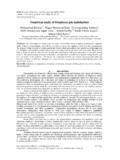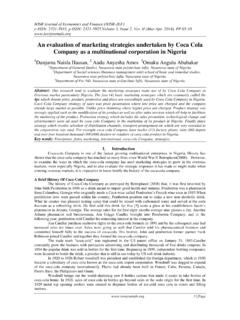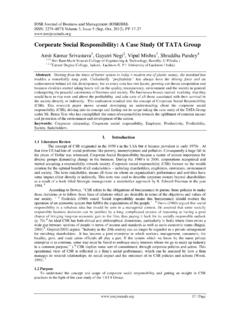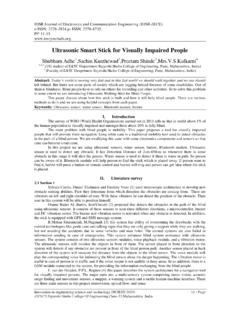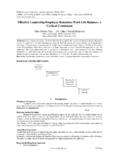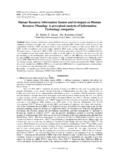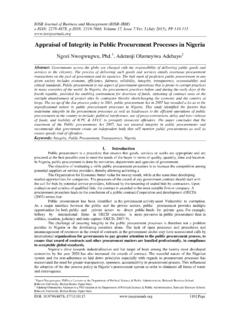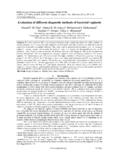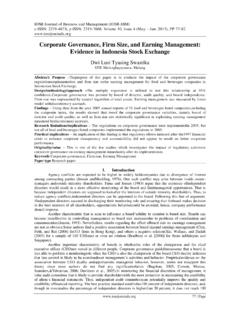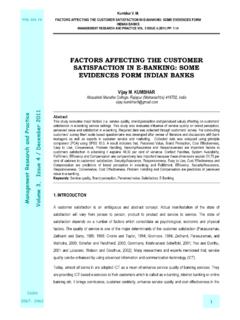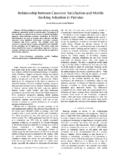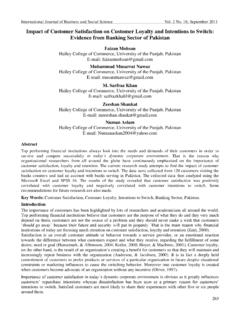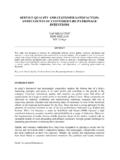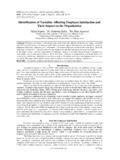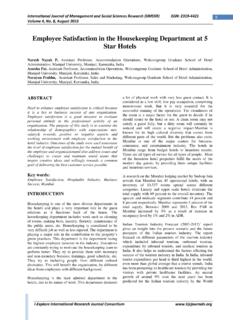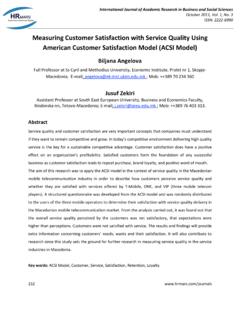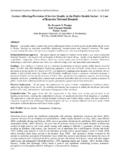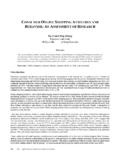Transcription of Customer Satisfaction in Online Shopping: a study into the ...
1 IOSR Journal of Business and Management (IOSR-JBM) e-ISSN: 2278-487X, p-ISSN: 2319-7668. Volume 11, Issue 6 (Jul. - Aug. 2013), PP 13-20 13 | Page Customer Satisfaction in Online shopping : a study into the reasons for motivations and inhibitions Rashed Al Karim (Assistant Professor, Business Administration, East Delta University, Bangladesh) Abstract: This study endeavours to understand Customer Satisfaction in Online shopping while investigating the major reasons that motivated customers decision-making processes as well as inhibitions of Online shopping . The Kotler and Killers (2009) Five Stage Buying Process Model was chosen as the basis of framework of this study to explain Customer Satisfaction through their motivations to buy products Online . The existing literature was reviewed to discover reasons that would influence customers positively or negatively towards shopping Online .
2 Surveys were conducted by distributing questionnaires in the Wrexham area (North Wales) to gather data for this research. SPSS software package was used to present research data graphically and to test research hypothesis. From the findings, it was discovered that respondents use internet to purchase products through Online because they believe it is convenience to them and the term convenient includes elements such as time saving, information availability, opening time, ease of use, websites navigation, less shopping stress, less expensive and shopping fun. In contrast, along with respondents mind-sets, Online payment security, personal privacy and trust, unclear warranties and returns policies and lack of personal Customer service are the foremost barriers of Online shopping . Furthermore, the result of hypotheses established that even though Online shopping is convenient to all consumers, Online payment system and privacy or security anxieties have significant impact on Online shopping .
3 Finally, some recommendations have been offered for Online retailers to take initiatives for making Online shopping more admired and trustworthy. Keywords: Customer Satisfaction , Customer motivation and inhibition, On-line shopping , On-line vendor, SPSS software. I. Introduction With the rapid global growth in electronic commerce (e-commerce), businesses are attempting to gain a competitive advantage by using e-commerce to interact with customers (Demangeot and Broderick, 2007). Nowadays, Online shopping is a fast growing phenomenon. Growing numbers of consumers shop Online to purchase goods and services, gather product information or even browse for enjoyment. Online shopping environments are therefore playing an increasing role in the overall relationship between marketers and their consumers (Koo et al. 2008). That is, consumer-purchases are mainly based on the cyberspace appearance such as pictures, images, quality information, and video clips of the product, not on the actual experience (Brennan et al.)
4 , 2008; Constantinides, 2004). As the Internet has now become a truly global phenomenon, the number of Internet users worldwide is expected to reach billion by 2010 according to the survey of ClickZ Stats, cited in Kotler & Armstrong (2008). This growing and diverse Internet population means that people having diverse tastes and purposes are now going to the Web for information and to buy products and services. Thus, the impact of these Online shopping environments on consumer response necessitates a critical understanding for marketing planning. II. Problem statement According to the Survey of eMarketer s (Aug, 2009), in 2009, million (ages 14+) UK people had Internet access and from that million internet users are actually using internet to buy products or services. This represents of UK Internet users ages 14 and older will buy at least one item via the Online in 2009. Between 2009 and 2010, the number of Online buyers will rise from million to million ( ).
5 As well as, in 2009, UK business-to-consumer (B2C) Online sales (including digital downloads and tickets for travel and events) will total billion which is more than 2008 and more than 2007 as shown in and graphical comparison between Internet users & Online buyers (2007-2010) is shown in (eMarketer, August, 2009). Customer Satisfaction in Online shopping : a study into the reasons for motivations and inhibitions 14 | Page Source: Adapted from eMarketer (August, 2009); available at : Comparison between Internet Users & Online Buyers (2007-2010) Though Online users are increasing frequently, Online shoppers are not increasing as many as users increasing. There might have some reasons. Research on Online shopping has been carried out for the last two decades. Since then consumers beliefs to Online shopping is increasing, but how much their perceptions are about Online shopping still need to be researched.
6 As said by Monsuw et al, (2004) customers attitudes can be change by demographic, geographic or security reasons, thus in view of that it is needed to investigate how the content and presentation of product and service information affect consumers willingness to patronize an Online store and also needed to identify several factors affecting Online consumers purchase behaviour as well as their perception and Satisfaction in UK, particularly in the North Wales (Wrexham) area. Research Objectives: Therefore, the aim of this research is to explore consumer perceptions of Internet-based e-retailing and scrutinize the major factors that influence the Online consumer s shopping behaviour in decision-making process. The specific objectives of the research are: 1. To explore the reasons why despite increase in internet users, Online shopping has not been increasing. 2. To discover the individual factors that might, on one hand, prompt a buyer to make an Online purchase decision and on the other hand, restrain from such decisions.
7 3. Finally to put forward some recommendations to the e-tailers in order to improve the current situation. Literature Review: According to Kotler & Keller (2009), a buyer goes through five stages while making a decision to purchase. These stages are best explainable when a buyer goes for buying costly items, such as a house, a car, diamond jewellery etc. However, in day- to- day purchase, consumers may not go through all these stages, since some commodes do not need information, and based on buyer s previous experience they will visit a store for the purchase. These stages are (Figure 1): problem recognition, information search, evaluation of alternatives, purchase decision, and purchase behaviour (Kotler & Keller 2009). between Internet Users & Online Buyers (2007-2010)Internet Users ages 14+ (millions) Online buyers ages 14+ (millions) : UK Online Buyers and Penetration, 2007-2010 Year 2007 2008 2009* 2010* Internet Users ages 14+ (millions) Online buyers ages 14+ (millions) Online buyers % of Internet Users Online sales (billions) Note: * converted at average annual exchange rates (projected for future years) Customer Satisfaction in Online shopping .
8 A study into the reasons for motivations and inhibitions 15 | Page Figure 1 In addition, many marketing activities ( relationship marketing, marketing research, data mining, promotion/communications, supply chain management, sales and purchasing and after sales support) are now technology enabled due to the increasing expansion of Online marketing via the Internet (O Connor & Galvin, 2001). Companies are now using the Internet to build closer relationships with consumers and marketing partners. Besides competing in traditional marketplaces, they now have access to exciting new market spaces. Moreover, through the Internet, consumers can learn about design, order, and pay for products and services, without ever leaving home and then, through the wonders of express delivery, they can receive their purchases in short time.
9 From virtual reality displays that test new products to Online virtual stores that sell them, the technology explosion is affecting every aspect of marketing. The Internet has now become a truly global phenomenon (Srisuwan & Barnes, 2008; Teng et al., 2007). Besides, Jayawardhena et al. (2007) in their study considered the purchasing orientation of potential buyers and assessed its impact on purchase behaviour, but found that individual orientation is independent of purchasing decision, which reinforces the views of Liu et al. (2008) and Sorce et al. (2005) that every stage of the purchasing decision making cycle may have impact on a potential buyer s decision to buy Online or not. Demangeot and Broderick (2007) reported that information search experiences affect the attitudes towards the site and its brands . In the Koo et al. (2008) study , which was conducted on 279 Online customers in Korea, it was found that per cent use the internet for news and information, per cent for communication, per cent use it for entertainment while percent for Online shopping .
10 Furthermore, in consistent with Gay et al. (2007), Yun and Good (2007), Lee and Lin (2005), Rajamma et al. (2007) , Kim and Kim (2004) , Ramus and Nielsen (2005) , Ladson and Fraunholz (2005), Kramarae and Kramer (1995), Welch (1995), Rathmell et al. (1998), Johnstone (1999), Singh (2004), Smith & Chaffey (2002), and Canavan et al. (2007),: consumer Satisfaction and purchase decision on Online shopping depends on few more issues. These are: e-store image, delivery and Customer services, service quality and purchase behaviour, personalisation, motivations for Online purchase, trust, reliability, privacy, transaction and cost, incentive programmes, web-site design, Online interactivity, merchandise motivation, assurance, convenience (or Hassle Reduction), pragmatic motivation, responsiveness, consumer risk assessment etc. Following from the above consideration, this research will find out the answers to the following specific question within a sample in Wrexham township, that are likely to formulate the findings of the research and from where attempts will be made to draw generalizations.
